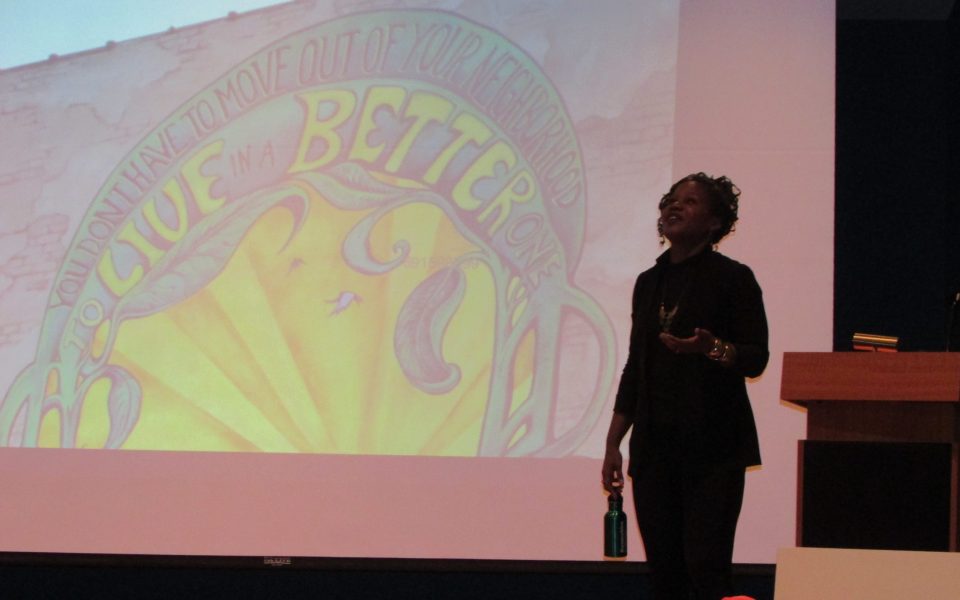Majora Carter is well aware that gentrification is the undeniable pressure point in race and class relations as the wealth gap continues to make cities more unlivable for poor people, particularly people of color.
Standing before about 50 people during a gathering hosted by the Greensboro Planning Department at the history museum on Monday, she shares that she swiped the term “self-gentrification” from the president of Johnson & Wales University, who wanted to improve the campus so students didn’t feel compelled to leave.
An environmental justice activist, MacArthur genius, broadcaster and now developer, Carter makes no secret of the fact that her approach to urban revitalization — a focus on creating attractive public spaces and commerce to retain talent over affordable housing — has attracted critics in her native South Bronx.
Advancing her PowerPoint presentation, she acknowledges an admiration for the design even if the message on the poster isn’t flattering. It includes a quote from her — “We like to see the work that we do as self-gentrification” — coupled with an attribution to “local sellout Majora Carter,” hash-tagged #ColumbusSyndrome.
Later, about 10 people would show up for a protest against her, unfurling a banner that took a dig at Boogie Down Grind, the coffeeshop she opened in the South Bronx. It read, “Majora Carter sells out the South Bronx 1 cup of coffee at a time.”
Among the 52-year-old social entrepreneur’s accomplishments in her two decades of work in the South Bronx are the development of a park along the Bronx River, the aforementioned coffee shop, and a tech hub that employs locals to do software testing. She proposed that a shuttered juvenile detention facility in the Bronx be refashioned into a mixed-use complex with housing, manufacturing and education, public space and commercial retail. Another developer won the contract, and Carter says she’s taking her concept to Indianapolis.
There’s no question about her qualifications as a guest speaker for the community presentation on Monday, part of a series of public conversations the planning department is hosting through the end of November as part of its effort to update the 15-year-old Comprehensive Plan.
But in an era when real affordable housing is becoming an ever scarcer commodity in American cities, Carter’s approach is by no means an easy call. If you revitalize a high-poverty community by building up talent and commerce but don’t replenish the supply of affordable housing, displacement would seem to be a predictable outcome. And Carter herself acknowledged a dark side to the Bronx renaissance, citing a statistic that the number of black-owned businesses in New York City is down 30 percent while the number of small businesses as a whole is on the rise in the city.
Carter’s desire to break up concentrations of poverty and her support for diversifying income levels aligns with the philosophy of Housing Authority of Winston-Salem CEO Larry Woods. Alongside the burgeoning growth of downtown Winston-Salem, gentrification is on a faster track in Greensboro’s neighboring city to the west. And with plans underway to demolish the Cleveland Avenue Homes public-housing community and efforts to sell off Crystal Towers and scatter the residents, anxiety about displacement is palpable.
The comment threads on Greater Greensboro Politics and other Facebook pages provide ample testimony that many Greensboro residents don’t think the city is doing enough to build affordable housing, but Carter’s reception on Monday night ranges from enthusiasm to low-key agreement.
“Are you willing to work here?” one man asks her.
Yes is the short answer. Without going into detail, Carter alludes to some frustration with the city of New York, intimating that the business climate is more favorable in the South.
“I can’t tell you how many people have come down to North Carolina or Atlanta,” she says. “It’s nice here.”
A professor who teaches a class on environmental racism at UNCG tells Carter she’s interested in leading a project in the area around Smith Senior Center. Using Carter’s terminology — “third space” and “hinge space” — she talks about her desire to enhance the sense of community and catalyze transformation. Notably, the senior center isn’t far from Revolution Mill and Proximity Mill, two mixed-use projects that area already transforming northeast Greensboro.
“What do people spend money on outside of the community?” Carter asks, adding that those would be obvious components for project. She mentions coffee shops, arcades and recording studios as candidates.
“If you can couple enterprise with social space, that’s always the better route,” she says.
Join the First Amendment Society, a membership that goes directly to funding TCB‘s newsroom.
We believe that reporting can save the world.
The TCB First Amendment Society recognizes the vital role of a free, unfettered press with a bundling of local experiences designed to build community, and unique engagements with our newsroom that will help you understand, and shape, local journalism’s critical role in uplifting the people in our cities.
All revenue goes directly into the newsroom as reporters’ salaries and freelance commissions.


Leave a Reply